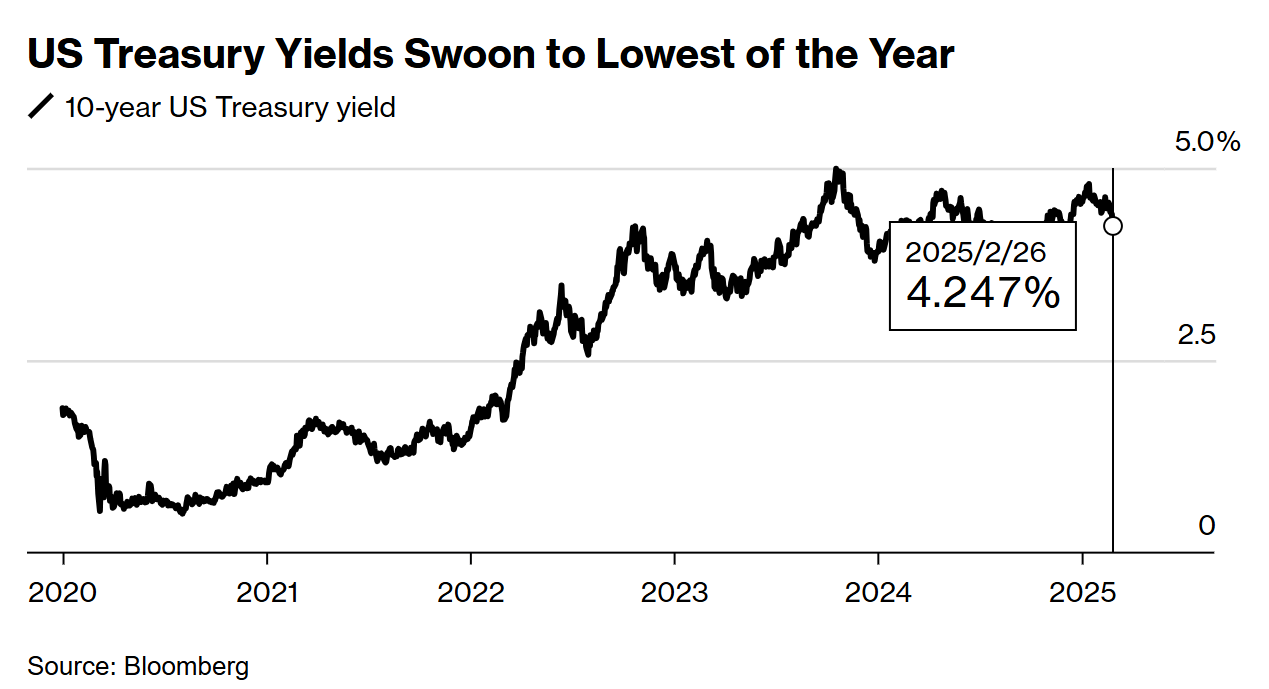US bond yields “fell” to a new low during the year, interest rate cut bets and policy changes triggered a bond-market frenzy
The Zhitong Finance App has learned that investors in US government bonds are beginning to bet that the Federal Reserve will soon shift from worrying about stubborn inflation to focusing on slowing economic growth. This sentiment propelled US Treasury bonds to rise for the sixth consecutive trading day, and yields fell to their lowest level this year. Meanwhile, a Morgan Stanley strategist said that if the market's general view of the Federal Reserve changes, the 10-year Treasury yield is likely to fall below 4%.

Figure 1
This week, traders resumed their expectations that the Federal Reserve will cut interest rates by 25 basis points twice this year and the third time next year. Interest rates are expected to drop to around 3.65%. Morgan Stanley pointed out that if the market's expected interest rate falls to 3.25%, the yield on 10-year treasury bonds may fall below 4%. The bank expects that the US personal consumption expenditure (PCE) price index for January, which will be released on Friday, will show a decline in the rate of price growth, which may be the decisive factor.
Morgan Stanley strategist Matthew Hornbach and others said in a report that if the Fed's rhetoric becomes more moderate due to improvements in core PCE inflation data, investors will buy more long-term bonds, thus allowing the market's implicit low interest rate to fall further.
According to information, all three fixed-rate treasury bond auctions this week received strong demand. The seven-year treasury bond auction ended on Wednesday. The yield of the $44 billion auction was 4.194%, lower than 4.203 percent of the pre-auction sale before the bidding deadline, indicating that demand exceeded traders' expectations. The two-year and five-year treasury bond auctions earlier this week had similar results.
Bloomberg macro strategist Alice Andres said that in the absence of other fundamental data (such as Friday's PCE data), it is unlikely that the transaction will fall below 4.25% (the next logical and psychological yield support level). However, she also pointed out that the risk is that falling below 4.25% may cause investors to worry about missing out on a rebound.
The 10-year Treasury yield fell to around 4.24% on Wednesday and rose slightly to 4.28% during the Asian trading session on Thursday. In the second half of last year, the yield fell below 4% for several months. Previously, employment data for July was clearly weak, and the Federal Reserve is expected to cut interest rates by 1 percentage point before the end of the year.
Subsequently, the process of reducing inflation came to a standstill, and the Federal Reserve suspended interest rate cuts in January, saying that cutting interest rates again might make the situation worse. Investors now see reasons for lower yields not only in economic growth indicators, but also in US fiscal and immigration policies. This includes US President Donald Trump's constant threat of imposing tariffs on major trading partners. This strategy damaged the economy during his first term and worried Federal Reserve policymakers.
Tough changes in immigration policy may cause short-term GDP growth next year to fall below potential levels, Hornbach wrote. Investors' increased attention to immigration trends should lower expectations of neutral interest rates, which are still high.
So far this year, Bloomberg's index for measuring US Treasury yields has risen 2.3%, surpassing the 1.3% increase in the S&P 500 index. Most respondents to the MLIV Pulse survey in February predicted that US Treasury yields would surpass the US stock market in the next month.

Figure 2
On Wednesday, Trump gave a series of apparently conflicting answers to his plans to impose tariffs on Canada, Mexico, and the European Union.
EY chief economist Gregory Dacko said that the US economy is strong, but increased uncertainty about trade, fiscal, and regulatory policies is casting a shadow over the outlook, which may lead to financial market turmoil, and businesses and consumers are increasingly taking a wait-and-see attitude.
A new survey by the Federal Reserve Bank of Philadelphia found that nearly one-third of American workers are concerned about being fired by their employers. The sharp drop in consumer confidence on Tuesday was only the latest sign of a recession in the US economy. Citigroup's US Economic Accident Index fell to its lowest level since September, indicating that the data fell short of expectations.
Morgan Stanley said that since President Trump took office last month, cutting federal spending by firing government workers may also cause interest rate expectations to fall.
Meanwhile, the government and its congressional allies are implementing drastic tax cuts, which could widen the US budget deficit and require additional borrowing. The budget blueprint passed by House Republicans last night called for drastic spending cuts to offset the deficit.
Bianco Research president and macro strategist Jim Bianco said on Bloomberg TV that bonds are responding to the possibility of reduced supply. As to whether this will happen, that will be revealed later this year. As to whether this is stimulus or inflation, that will also be revealed later this year.
In terms of inflation, the PCE price index, which excludes food and energy, grew by about 2.8% for three consecutive months. Economists at Morgan Stanley predicted that the Federal Reserve would cut interest rates in June; now they expect the PCE price index to fall to 2.58% in January.
- SBNY
- 0.5500
- -15.38%
 Index Options
Index Options CME Group
CME Group Nasdaq
Nasdaq Cboe
Cboe TradingView
TradingView Wall Street Journal
Wall Street Journal